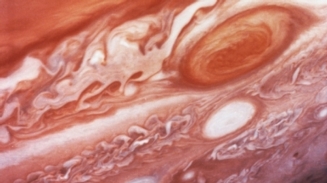
用“大红斑”解读木星上层大气温暖的秘密
Great Red Spot Helps Explain Jupiter's Warm Upper Atmosphere
用“大红斑”解读木星上层大气温暖的秘密
A thermal spike linked to the solar system’s largest storm explains weather on gas-giant planets
太阳系最大风暴所引发的热峰,可解释气体巨星上气象的成因。
撰文/播音 Lee Billings
翻译 郭丰茹
审校 丁可含
For most people, Jupiter’s most recognizable—and mysterious—feature is the Great Red Spot. For centuries, astronomers have watched the storm spin across the giant world’s face.
对很多人来讲,“大红斑”是木星最有特点和神秘感的标志。几个世纪以来,天文学家一直可以观测到暴风横扫气体巨星表面的景象。
But for planetary scientists, Jupiter’s most distinctive mystery may be what’s called the “energy crisis” of its upper atmosphere: how do temperatures average about as warm as Earth’s even though the enormous planet is more than five times further away from the sun?
但是对于行星科学家来说,木星最独特的奥秘可能是上层大气层的“能源危机”:尽管木星与太阳的距离是地球的五倍多,但为什么它的平均温度却和地球的相当呢?
All the sun’s giant planets display this energy crisis, and those in chilly orbits around other stars probably have it, too. So where does the energy to heat their upper atmospheres come from?
太阳系中所有的巨行星都有这样的能量危机,而且在其他星系的寒冷轨道上运转的行星可能也如此。那么,这些加热上层大气的能量从哪里来呢?
According to a new study, the energy must originate within the giants, get transported upward and become amplified by turbulent storms. The finding appears in the journal Nature. [James O'Donoghue et al., Heating of Jupiter’s upper atmosphere above the Great Red Spot]
This offers a new window into Jupiter’s depths, and should allow researchers to better understand gas-giant atmospheres throughout the universe. And it’s all connected to the Great Red Spot.
一项新的研究表明,这些能量来源于行星内部,向上传播,受猛烈的暴风影响而增强。这项研究结果见报于《自然》杂志。[James O'Donoghue et al., Heating of Jupiter’s upper atmosphere above the Great Red Spot] 这为木星内部研究提供了新视角,应有助于探究宇宙中其他气体巨行星的大气形成。这一切都与大红斑有关。
Astronomers have long known that auroral displays can heat Jupiter’s poles, where charged particles trapped in the planet’s intense magnetic field slam into its upper atmosphere. Some theorists thought this auroral heating could flow toward the equator to warm the planet’s mid-latitudes. So, using NASA’s Infrared Telescope Facility, astronomers observed Jupiter for nine hours, looking for these flows as thermal fluctuations in the planet’s upper atmosphere.
But they saw none.
天文学家已经知道,极光的出现可以加热木星的两极。在那里带电粒子会被被行星的强磁场捕获冲入上层大气层。有些理论家认为,极光加热的空气可以流向赤道从而使中纬度地带升温。因此,为了寻找木星上层大气层中的热量流,天文学家用美国宇航局(NASA)的红外望远镜设备对木星进行了长达9小时的观测,但并未观测到。
Instead, in Jupiter’s mid-latitudes they spied a thermal spike 800 kilometers above the Great Red Spot, where temperatures soared hundreds of degrees higher than the surroundings. The best way to explain this spike is from the swirling maelstrom below, where turbulent atmospheric waves must generate heat by crashing together like breakers on a windy beach shore. Though this must be a planet-wide phenomenon, it is most obvious directly over Jupiter’s largest, most powerful storm.
而在木星中纬度地带,他们在“大红斑”上方800千米的位置探测到一个热峰,那里的温度比周围高出几百度。这个热峰来源于大漩涡底部,涡流搅乱大气层,通过碰撞产生热量,就像海浪冲刷着多风的海岸。尽管这个气候现象普遍存在于行星中,但在木星最大最强劲的暴风上方最明显。
As alien as it seems, scientists have seen the same behavior on much smaller, gentler scales here on Earth, when thunderheads rising over mountain ranges create rippling waves that heat the air above.
—Lee Billings
[The above text is a transcript of this podcast.]
这看似陌生,其实科学家们已经在地球上观测到这一现象,只是规模较小、不那么明显。例如,当山间升起积雨云时,形成的涟漪便会加热上空的空气。
未经书面许可任何人不得复制或镜像
京ICP备11000850号-1
 京公网安备11010502039775号
京公网安备11010502039775号 信息网络传播视听节目许可证0111611号
国家科技基础条件平台

















